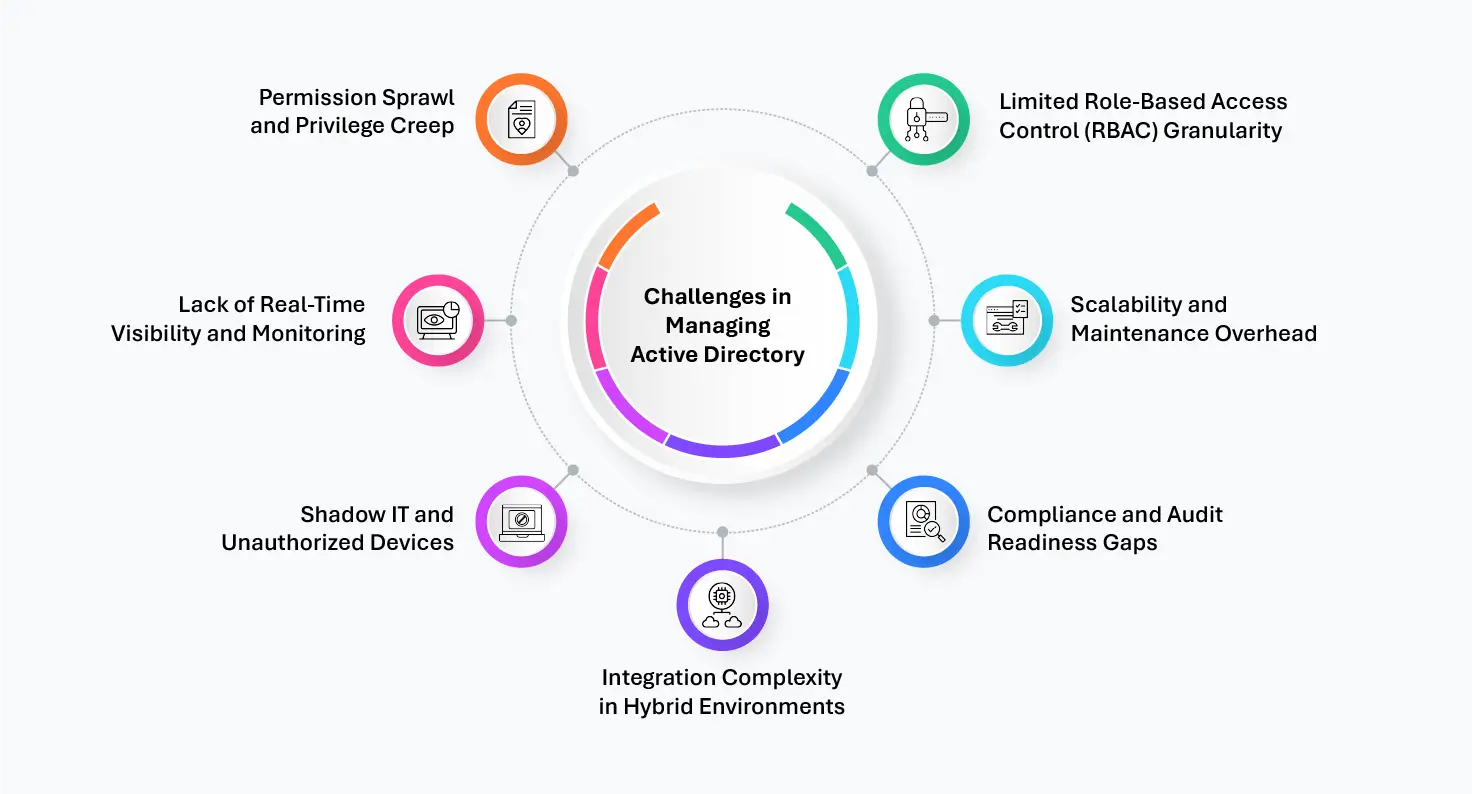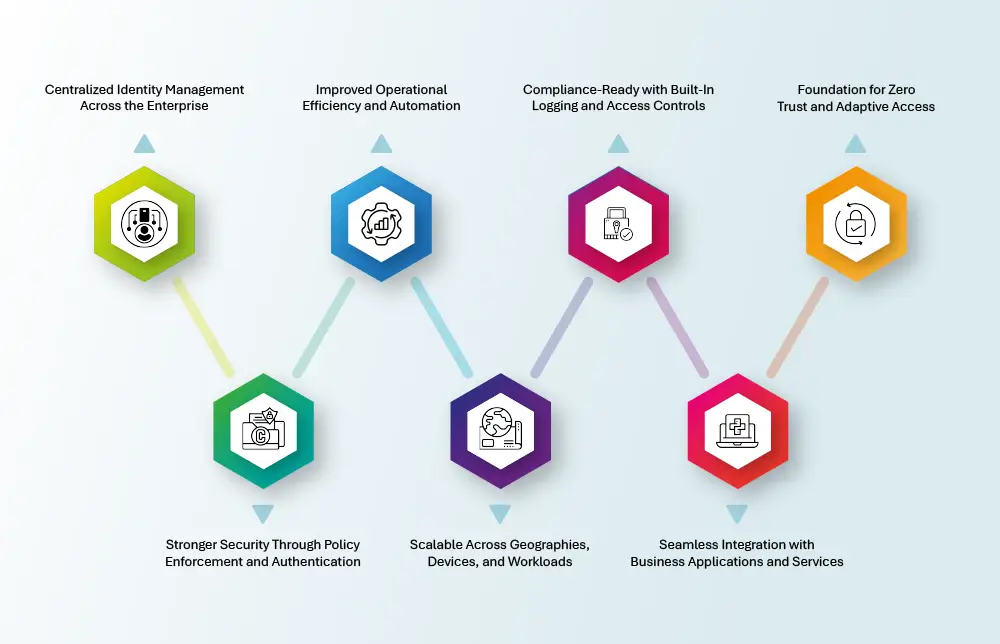What is Active Directory (AD)?
Active Directory (AD) is a directory service developed by Microsoft that provides centralized management and control over user identities, roles, and access to resources within an organization. Integration with Active Directory ensures that information and actions are aligned with users’ roles and responsibilities, facilitating consistent application of corporate governance policies. By giving data owners control over their data while maintaining adherence to company policies, Active Directory enhances standardization and security across the organization.
Introduced with Windows 2000 Server, Active Directory plays a foundational role in enterprise IT infrastructure, ensuring that only authorized users have access to specific resources—while enforcing security policies and facilitating compliance.
Why Active Directory Matters
In today’s hybrid work environments, where employees and workloads span across on-premises and cloud systems, AD provides the critical control layer that governs identity and access. It’s not just about logging in—Active Directory determines who can access what, when, and how—all while keeping an audit trail to support security and compliance.
Without a centralized directory service like AD, organizations risk fragmented identity management, increased vulnerability to insider threats, and difficulties in meeting compliance mandates such as GDPR, HIPAA, and the DPDP Act.
Key Components of Active Directory
- Domain Services (AD DS): Core to AD, this component authenticates users and computers, assigns security policies, and stores directory data.
- Group Policy: Allows IT administrators to define user settings across systems, simplifying security enforcement and standardization.
- Lightweight Directory Services (AD LDS): A lighter version of AD DS, providing directory services without domain-related infrastructure.
- Certificate Services (AD CS): Facilitates digital certificate creation and management for encryption and secure identity.
- Federation Services (AD FS): Enables single sign-on (SSO) across enterprise boundaries by securely sharing identity information.
- Rights Management Services (AD RMS): Controls access to sensitive documents and emails through usage policies.
Modernizing Active Directory for the Cloud and Zero Trust Era
As enterprises adopt cloud-based platforms like Microsoft Azure and migrate workloads to hybrid environments, traditional AD evolves. Azure Active Directory (Azure AD) extends identity management to cloud applications, offering multi-factor authentication (MFA), conditional access, and deep integration with SaaS platforms.
In a Zero Trust architecture, where “never trust, always verify” is the baseline, Active Directory becomes the backbone of identity-centric security. Modern AD implementations help enforce access based on identity, device health, geolocation, and real-time risk, making it a crucial enabler of Zero Trust frameworks.
Challenges in Managing Active Directory

While Active Directory remains a cornerstone of enterprise identity management, it is not without its complexities—especially in today’s dynamic, hybrid IT environments.
1. Permission Sprawl and Privilege Creep
Over time, users often accumulate access rights they no longer need, a phenomenon known as “privilege creep.” As groups nest within groups and roles change, permissions can become outdated, redundant, or overly permissive—creating hidden security risks and violating the principle of least privilege.
2. Lack of Real-Time Visibility and Monitoring
Traditional AD environments often lack continuous insight into who accessed what, when, and from where. Without real-time visibility into user behavior, IT teams can miss early warning signs of insider threats, compromised credentials, or misconfigurations.
3. Shadow IT and Unauthorized Devices
Employees using unmanaged applications or personal devices to access enterprise resources bypass AD’s governance controls. This decentralization of access weakens centralized enforcement and expands the attack surface for breaches.
4. Integration Complexity in Hybrid Environments
Synchronizing on-prem AD with cloud-based services like Azure AD requires meticulous configuration. Inconsistent policies, replication delays, or authentication issues can cause service disruptions and introduce security vulnerabilities.
5. Compliance and Audit Readiness Gaps
With compliance regulations like GDPR, HIPAA, and the DPDP Act demanding detailed access logs and role-based accountability, many legacy AD setups fall short. The absence of automated auditing tools and lineage tracking makes regulatory reporting slow, manual, and error-prone.
6. Scalability and Maintenance Overhead
As enterprises grow, managing an ever-expanding AD forest—across geographies, departments, and cloud services—becomes increasingly difficult. Frequent patching, replication management, and cleanup of stale objects consume valuable IT resources.
7. Limited Role-Based Access Control (RBAC) Granularity
AD’s native RBAC capabilities often lack the fine-grained control needed for today’s diverse user groups. Custom role definitions and dynamic, context-aware access logic are typically layered in through third-party tools or extensions.
Benefits of Active Directory

Despite the complexities, Active Directory (AD) continues to be the backbone of identity and access management for enterprises—and for good reason. Its benefits extend beyond basic authentication to support governance, security, scalability, and compliance in an increasingly digital and hybrid world.
1. Centralized Identity Management Across the Enterprise
AD provides a unified directory where user identities, credentials, and access policies are centrally stored and managed. This streamlines onboarding and offboarding processes, ensuring that users have timely and appropriate access while minimizing human error. With one source of truth for authentication, administrators can enforce consistent policies across departments and systems.
2. Stronger Security Through Policy Enforcement and Authentication
By integrating with Group Policy and supporting Multi-Factor Authentication (MFA), AD enables organizations to enforce robust security protocols. It helps mitigate the risks of password reuse, phishing, and unauthorized access. Security policies—such as password complexity, account lockout, and session timeouts—can be enforced uniformly across the network.
3. Improved Operational Efficiency and Automation
Active Directory supports automation through scripting and group policies, reducing manual administrative overhead. Routine tasks such as assigning user roles, resetting passwords, or provisioning devices can be handled automatically or through self-service portals—freeing up IT teams to focus on more strategic initiatives.
4. Scalable Across Geographies, Devices, and Workloads
From startups to multinational corporations, AD is designed to scale with the business. It supports distributed environments, trust relationships between domains, and replication mechanisms that ensure consistent access no matter where users are located—on-premises or in the cloud. With Azure AD, organizations can further extend scalability to SaaS applications and mobile devices.
5. Compliance-Ready with Built-In Logging and Access Controls
AD provides the auditability and transparency required to meet regulatory standards like GDPR, HIPAA, SOX, and DPDP. Detailed event logs, object permissions, and user access histories allow organizations to prove compliance, respond to audits, and reduce regulatory risk. When integrated with security tools, AD can serve as the foundation for continuous compliance monitoring and risk assessment.
6. Seamless Integration with Business Applications and Services
AD is compatible with thousands of enterprise applications, making it easy to integrate identity and access controls across the business stack. Whether it’s connecting to Microsoft 365, ServiceNow, SAP, or other third-party platforms, AD ensures users enjoy a seamless single sign-on (SSO) experience while IT maintains control over permissions.
7. Foundation for Zero Trust and Adaptive Access
Modern AD deployments—especially when paired with Azure AD and conditional access policies—enable dynamic and context-aware security models. They serve as a building block for Zero Trust architecture, evaluating users not just based on identity, but also on device health, location, risk level, and session behavior.
The Future of Active Directory: Evolving for AI-Driven, Data-Centric Enterprises
As enterprises become increasingly digital and AI-powered, the role of identity and access management is undergoing a transformation—and Active Directory is at the heart of it. No longer just a user directory, AD is evolving into a critical control plane for enforcing data governance, enabling secure collaboration, and operationalizing Zero Trust principles.
In AI-driven environments, where algorithms access vast volumes of sensitive data for training and decision-making, identity becomes the new perimeter. AD’s integration with modern tools—like behavioral analytics, dynamic risk scoring, and AI-powered anomaly detection—is reshaping how access decisions are made. Instead of static permissions, enterprises are moving toward adaptive, context-aware authentication that responds to real-time threats.
Additionally, the rise of multi-cloud architectures and edge computing requires AD to be more flexible, decentralized, and API-driven. Enterprises are now demanding directory services that not only authenticate users but also orchestrate access across data lakes, SaaS platforms, and AI pipelines—while maintaining compliance with global privacy regulations.
To meet these demands, modern extensions like Azure Active Directory and cloud-native identity providers are bridging the gap between traditional AD and next-gen workloads. The future will likely see AD functioning as a federated identity layer that supports decentralized data ownership, fine-grained access policies, and autonomous AI governance.
In essence, as businesses re-architect themselves around data and intelligence, Active Directory is no longer just an IT utility—it’s a strategic enabler of secure innovation, regulatory resilience, and digital agility.
Getting Started with Data Dynamics:
- Learn about Unstructured Data Management
- Schedule a demo with our team
- Read the latest blog: AI, Ethics, and Compliance: The Next Frontier in Global AI Leadership






